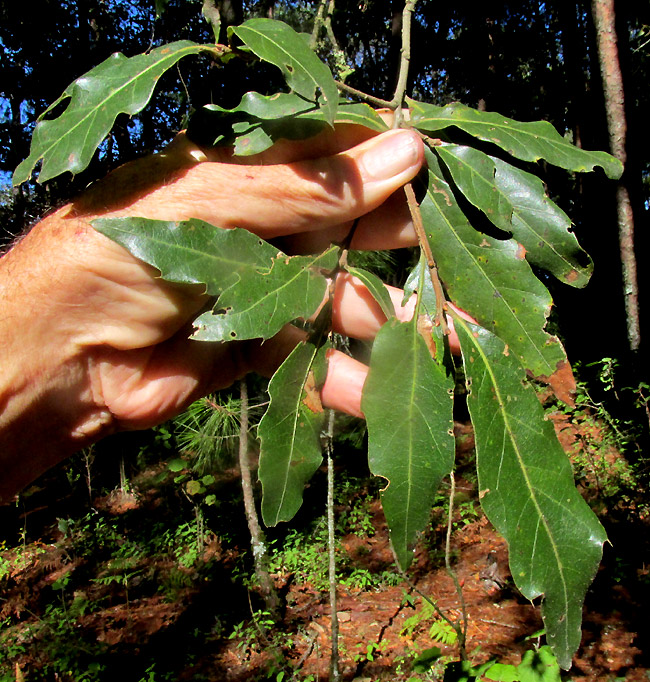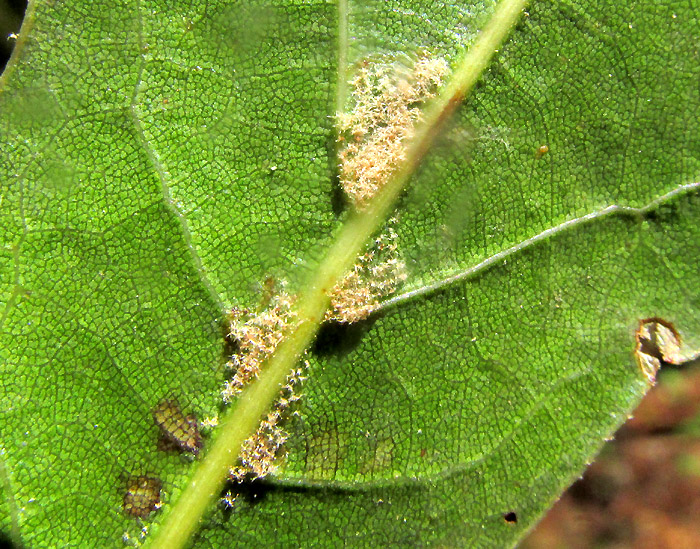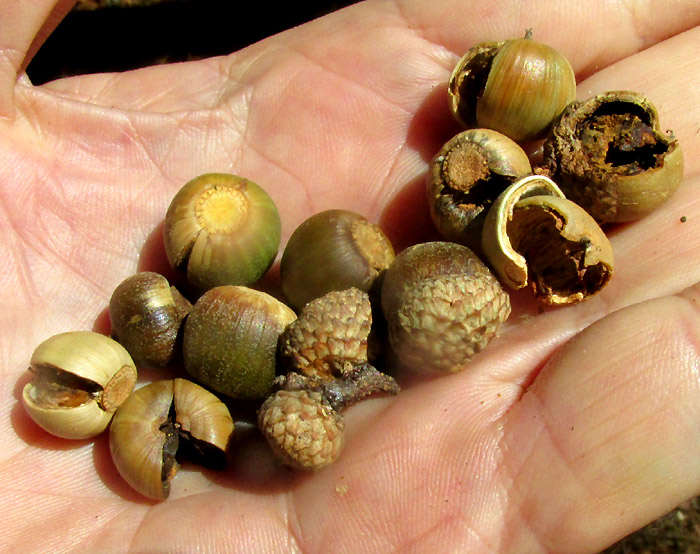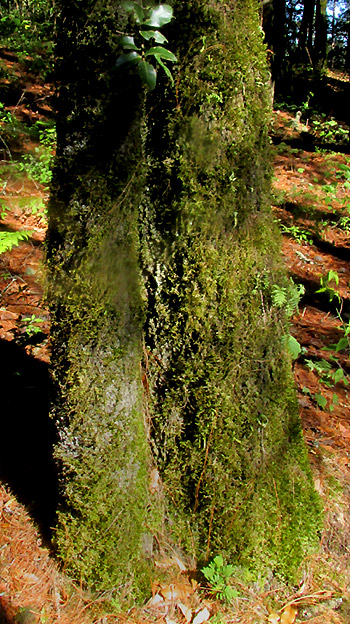Excerpts from Jim Conrad's
Naturalist Newsletter
Entry from field notes dated September 3, 2023, taken in Los Mármoles National Park in the Eastern Sierra Madre mountains, Hidalgo state, MÉXICO; oak-pine forested mountain peak about 3km west of Puerto de Piedra, on road branched off the road between Trancas {on maps designated "Morelos (Trancas)"} and Nicolás Flores; limestone bedrock; elevation ~2,650m (~8,700ft); N20.816°, W99.214°
QUERCUS AFFINIS

It's always a pleasure to see any healthy oak tree. Oaks belong to the genus Quercus, the largest genus in the Oak/Beech/Chestnut Family, the Fagaceae. With about 160 oak species just in Mexico, Mexico is the center of species diversity for the whole world.
In the oak-pine forest mantling this mountain range, the above species was most common at higher elevations. Field marks distinguishing the leaves from those of other oak species include: their relatively small size; the blades gradually narrowing to short petioles; being widest at their tops or middles, and; usually having just two or three low teeth mostly occurring toward their tips.

Important in oak identification is the presence or absence on blade margins of short, needlelike projections at tooth tips, as seen above. Especially notable for this species is that on its leaf undersurfaces, secondary veins are very low, somewhat flattish, seeming sunken into the blade tissue. This species is similar to and very closely related to another oak common in Mexico's uplands, Quercus laurina, but that species' veins emerge prominently over above the surface. Also, the upper blade surface of Quercus laurina typically is rougher in texture than on our tree. Notice how slender the twig is, and short the petiole, the small buds, and the twig's gray-brown color.

On this species' blade undersurfaces, tufts of branched, matted hairs gather in axils between the midrib and secondary veins. Such tufts are called "domatia" and have been documented as providing living quarters for mites. Many oak species don't produce them.

Acorns found below the tree were very similar to those of Quercus affinis: egg-shaped or almost spherical; cups not rolled inside at their margins and; cups covering a third or half of the nut.

The tree's trunk was deeply fissured on one side, possibly caused by lightning damage here at the mountain's peak, or maybe a roving cow stripped off a branch when the tree was a seedling. In this borderline cloud forest, mosses and lichens thickly covered its trunk.
All the above field marks point to QUERCUS AFFINIS, with no English name despite its being one of the most characteristic trees of Mexico's eastern and central upland forests. However, it's endemic just to Mexico. It favors limestone soils.
Mexico's oak-pine forests have been very extensively logged for timber, firewood and charcoal, and oaks are especially prized for their hard, durable wood. Oak-pine forests often coincide with high human population densities, so also much oak-pine forest has been completely obliterated for agriculture and cattle pastures. Normally the remaining forests are subject to considerable, often illegal firewood gathering, and cattle are allowed to roam freely. Still, thanks to its former great numbers and its being a robust tree with relatively flexible habitat requirements, remaining populations are regarded as stable.
However, it's worthwhile to think about the future of species such as Quercus affinis in terms of climate change. For her 2021 thesis entitled "Impacto del Cambio Climático sobre Especies Amenazadas de Encino (Quercus: Fagaceae) en México," Flor Daniela Navarrete López, suggested four projected scenarios of how ongoing climate change could affect 28 Mexican oak species, including Quercus affinis.
Projection 1 predicted a disappearance in Mexico's southern altiplano, and a reduction in the Eastern Sierra Madres, though in the Southern Sierra Madres conditions may improve. In the central Trans-Mexican Volcanic Belt, conditions favoring the species rose in altitude, while in the highlands of Chiapas and the Western Sierra Madres, conditions improved.
Projection 2 saw the disappearance of favorable conditions nearly everywhere, except in the Sierra de Juárez of the southern Eastern Sierra Madres.
Projection 3 predicted an overall improvement of conditions for the species in the northern Eastern Sierra Madres, while all the rest of Mexico's populations lose their habitats, except for small parts of the northeastern Southern Sierra Madres.
Projection 4 suggested that in general the current population distribution could change but little, except for a reduction of the current areas.
These projections are more favorable for Quercus affinis than for many of Mexico's species. Nine species were found likely to face extinction, and one other probably would lose 95% of its distribution area. However, ten species were identified as probably increasing their distribution areas, or maintaining them, or at least surviving much better than the other species.
With these considerations, the main danger to oaks in Mexico was found to be that no effective measures are being taken to protect them.